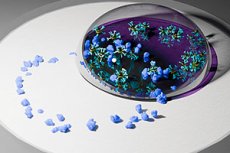New publications
From COVID to Cancer: New Home Test Detects Diseases with Astonishing Accuracy
Last reviewed: 15.07.2025

All iLive content is medically reviewed or fact checked to ensure as much factual accuracy as possible.
We have strict sourcing guidelines and only link to reputable media sites, academic research institutions and, whenever possible, medically peer reviewed studies. Note that the numbers in parentheses ([1], [2], etc.) are clickable links to these studies.
If you feel that any of our content is inaccurate, out-of-date, or otherwise questionable, please select it and press Ctrl + Enter.

Got a sore throat and stuffy nose? The advent of quick home tests has made it easy to tell whether you have a serious illness like COVID-19 or just spring allergies. But despite their speed and convenience, these tests are less sensitive than those used in clinics. This means that the result may be negative even if the person is infected.
The solution could be a new, low-cost biosensing technology that could make rapid at-home tests 100 times more sensitive to viruses like COVID-19. It could also expand rapid screening capabilities for other dangerous conditions like prostate cancer and sepsis.
Scientists at the University of California, Berkeley have developed a test that combines a natural evaporation process called the “coffee ring effect” with plasmonics and artificial intelligence to accurately detect disease biomarkers in just minutes.
“This simple yet powerful technique provides highly accurate results in a fraction of the time required for traditional diagnostic methods,” said Kamyar Behrouzi, a recent PhD candidate in microelectromechanical systems and nanoengineering at UC Berkeley.
“Our work paves the way for more accessible and affordable diagnostic solutions, especially for resource-limited regions.”
A description of the technology was published in the journal Nature Communications.
Coffee Ring Effect and Nanoparticles
If you look closely at a coffee or wine stain, you'll notice that it's darker at the edges than in the center. This is due to a physical phenomenon known as the coffee ring effect: when a drop of liquid evaporates, it creates a current that pushes suspended particles toward the edges. If the particles are pigmented, as in coffee or wine, a darker ring will form around the edges of the stain.
In 2020, Behrouz was developing a biosensor to detect COVID-19 and noticed that droplets of his experimental solution left ring-shaped marks when they dried. He realized that the coffee ring effect could be used to concentrate COVID-19 virus particles, making them easier to detect.
"We realized we could use this effect to create something much better than we originally planned," Behrouz said.
How does the test work?
The rapid test technology uses tiny particles called plasmonic nanoparticles that interact with light in a special way.
- The user applies a drop of liquid containing proteins associated with the disease (such as from a swab from the mouth or nose) to the membrane.
- When dry, the drop concentrates disease biomarkers in the coffee ring area.
- The user then adds a second drop containing plasmonic nanoparticles that “stick” to disease biomarkers.
If biomarkers are present, the nanoparticles form specific patterns that alter the way light interacts with the membrane. These changes can be seen with the naked eye or with an AI-powered smartphone app.
The technology provides results in less than 12 minutes and is 100 times more sensitive for COVID-19 than similar at-home tests.
Application for other diseases
“One of the key proteins we can detect with this technique is a biomarker for sepsis, a dangerous inflammatory response to a bacterial infection that can develop very quickly, especially in people over 50,” said senior study author Liwei Lin, a professor of mechanical engineering at UC Berkeley.
“Every hour counts, but culturing bacteria to identify the source of infection can take days. Our technique could allow doctors to detect sepsis in 10 to 15 minutes.”
Scientists have already created a prototype of a home test similar to rapid COVID-19 tests, with 3D-printed components that help correctly position the sample and apply plasmonic droplets.
"During the COVID-19 pandemic, we relied on home tests to see if we were infected. I hope our technology will make it more accessible to get regular screening for conditions like prostate cancer without having to leave home," Lin said.
